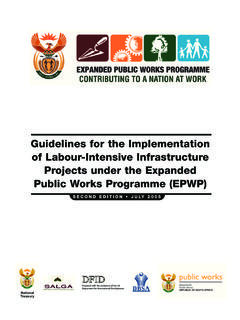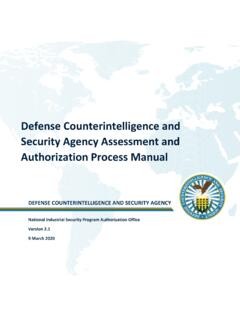Transcription of EPWP Large Projects Guidelines
1 EPWP Large Projects GuidelinesScaling Up Service Delivery and Contributing to Job CreationVersion 1: August 2012index PageGlossary of Terms 5 List of Abbreviations 8 Executive Summary 91. Introduction 10 Purpose of the Guidelines 10 Scope of the Guidelines 10 Application of the Guidelines 12 Overview of Expanded Public Works Programme (EPWP) 12 EPWP Phase 1 (April 2004 to March 2009) 13 EPWP Phase 2 (April 2004 to March 2014) 132. Definition of an EPWP Large Project 14 EPWP Large Projects defined Rationale for Large Projects 14 Addressing socio-economic imperatives 14 Development support to emerging enterprises 15 3. Implementation approaches for EPWP Large Projects 16 Labour intensification in an EPWP Large Project 16 Large contractor using Large -intensive construction methods 16 Subcontractor implements the labour-intensive components of the project 17 Bundling of smaller contracts to form a Large project 194.
2 Identification of Suitable Large Projects for Implementation using Labour-Intensive Methods 20 Types of activites than can be implemented labour-intensively in EPWP Large Projects 21 Road works 21 Stormwater works 21 Sewers 21 Water 22 Haul of materials 22 Electricity 22 Houses, School and Clinics 22 2 Page Possible Contracting Arrangements 22 Option 1: Programme management approach (design by employer) using labour-intensive methods 22 Option 2: Programme management approach (develop and construct) for Large Projects using labour-intensive methods 26 Option 3: Management contracts for Large Projects using labour-intensive construction methods 27 Determine contracting arrangements strategy 28 Forms of Contracts for an EPWP Large Project 29 Decision criteria for the selection of a suitable form of contract for construction works 30 Determine procurement arrangements (Decide on Quality strategy) 32 Design and Documentation for EPWP Large Projects 33 Design and documentation compliance to EPWP Guidelines 33 Labour-intensive compliance for Built-Environment Professionals 33 Labour-intensive construction compliance for contractors 33 Construction Industry Development Board compliance requirements 34 5.
3 Monitoring and Reporting Requirements of EPWP Large Projects 36 Monitoring Indicators 36 EPWP reporting Templates 37 Progress Monitoring 37 References 383 EPWP Large Projects Guidelines - Scaling Up Delivery and Job Creation4 List of Figures, Tables and AnnexuresFigure 1 Overview of the EPWP Large Projects GuidelinesFigure 2 Proposed Service Delivery model: Programme Management (Design by Employer)Figure 3 Stages of Delivery of an EPWP Large ProjectFigure 4 Management Contract of an EPWP Large ProjectFigure 5 Decision criteria for the selection of a Form of Contract for Construction and MaintenanceFigure 6 Deciding on procurement arrangements for EPWP Large ProjectsFigure 7 Single Volume Approach to the packaging of construction procurement documents Figure 8 Three Volume Approach to the packaging of construction procurement documentsTable 1 Recommended combinations of Forms of Contract and Forms of SubcontractTable 2 Decision criteria for the selection of the Form of Contract for Construction WorksAnnexure A An Overview of Contracting Strategies for Construction and Engineering ProjectsAnnexure B Review of eThekwini Metropolitan Municipality Infrastructure Delivery Model - An example of an EPWP Large Project Case StudyAnnexure C Municipality Reporting TemplateAnnexure D Provincial Reporting
4 TemplateList of FiguresList of TablesList of Annexures5 Glossary of TermsActual Expenditure Actual expenditure = (the expenditure on the project by the contractor ) + (the expenditure by the professional service provider appointed to design and supervise the project). The actual expenditure excludes expenditure on government management and administration. Code of Good Practice for employment and conditions of work for Expanded Public Works Programmes The Minister of Labour periodically issues a Ministerial Determination in terms of the Basic Conditions of Employment Act of 1997 and Gazetted a Code of Good Practice for employment and conditions of work for Expanded Public Works Programmes which allows for special conditions to facilitate greater employment on Expanded Public Works Programmes (EPWP). contractor A person, trading entity or group of persons who is contracted to carry out the work on the Expanded Public Works Programme for the relevant public body or client costs This is a combined cost of labour, plant and materials, excluding professional per FTE Cost per FTE is calculated by: dividing the total budget for an EPWP project by the number of full time equivalent jobs (FTEs) planned to be Rate A worker is paid a fixed sum each day in return for (i) working a fixed number of hours during that day, or (ii) completing a fixed task for that Characteristics of Workers The number of workers that fall within the following categories must be recorded: Youth ( to 35 of age) (youth who are still at school shall not be employed on EPWP Projects ); Women; People with Disabilities.
5 The definitions contained in the Preferential Procurement Regulations of 2001 for these categories of beneficiaries will be Large Project A Large project could either be one big project or a grouping of a number of related small initiatives (various mini- Projects ) managed in a coordinated way to obtain benefits and control not available from managing them individually. For the purpose of these Guidelines , the budgetary threshold of an EPWP Large Project is R30 million (Including Value Added Tax) and above. EPWP Target Group Unemployed, local, low skilled South Africans willing to work on EPWP Projects and programmes for a minimum wage Worker A person employed to work in an EPWP project under the Code of Good Practice for Expanded Public Works Programmes or the Learnership Determination for unemployed learners, whether they are employed directly by a government department, an implementing agent , a contractor or a Time Equivalent (FTE) FTE refers to one person-year of employment.
6 One person year is equivalent to 230 per- son days of work. Person-years of employment = total number of person days of employment created for targeted labour during the year divided by 230. For task-rated workers, tasks completed should be used as a proxy for 8 hours of work per Target FTE Target means the targeted number of Full Time Equivalent an employment programme required to create using funding received by a public body within a stipulated financial Large Projects Guidelines - Scaling Up Delivery and Job Creation6 EPWP Large Projects Guidelines - Scaling Up Delivery and Job CreationImplementing agent (IA) A business, institution or person who is contracted to implement the Expanded Public Works Programme on the relevant department s behalf. An implementing agent is bound by the same terms and conditions governing the implementation of Expanded Public Works Programme as a Grant / Amount The Incentive Grant / Amount earned is calculated as follows = Number of FTEs reported [by the end of a quarter] x Incentive subsidy per Creation Targets The number of full time equivalent jobs and work opportunities that a public body must Opportunity 1 job opportunity = paid work created for an individual on an EPWP project for any period of time.
7 In the case of social sector Projects , Learnerships will also constitute job opportunities. The same individual can be employed on different Projects and each period of employment will be counted as a job Performance Indicators (KPIs) Indicators are qualitative and/or quantitative measure/markers that define how performance toward the achievement of the programme, project or activity objective will be measured. Labour Intensity Labour intensity refers to the labour component of a project and is calculated as the percentage of unskilled labour wages against the total Construction Methods of construction involving a mix of machines and labour, where labour, utilising hand tools and light plant and equipment, is preferred to the use of heavy machines, where technically and economically contractor A person or firm undertaking a major contract and employing one or several subcontractors to carry out specific parts of the work or provide services, labour or contractor An experienced (main)
8 contractor who is contracted to be responsible for the construction of a project through an agreement that he / she manages one or a number of smaller subcontractors for different parts of the Provision of guidance, advice, technical and management support to emerging contractors or professionals to enable them to implement infrastructure Projects successfully and eventually establish themselves in a competitive Monitoring is a process that involves measuring and tracking progress according to the planned outputs / outcomes including: resources, activities, quality, costs, timeframes, of Employment created The number of people who worked on a project x the number of days each person A programme is a coordinated approach to explore a specific area related to an organisation s mission. It usually includes a plan of action or events which identifies staff and related activities or Projects leading towards defined and funded goals.
9 7 EPWP Large Projects Guidelines - Scaling Up Delivery and Job CreationProject A specific intervention with a beginning and an end, with a number of distinct phases in between. A project is designed to achieve specific objectives within predetermined implementation timeframes, with a budget with an associated cash-flow, and has a single point of responsibility (project manager). Project Budget The project budget = (the price tendered by the contractor ) + (the professional fees for the professional service provider appointed to design and supervise the project). The project budget excludes govern- ment management and administration Wage Minimum Daily Wage Rate = daily wage (whether task-rated or time-rated) per individual project. This wage rate must be inserted in the Project tender document as per the EPWP Body A provincial or national department, national or provincial public entity or constitutional institution within the meaning of the Public Finance Management Act, 1999, a municipality and municipal public entity within the meaning of the Municpal Finance Management Act, 2003.
10 Reporting Reporting is a process of recording EPWP project data/information from sites and uploaded into the EPWP reporting system on a frequency determined by the EPWP Monitoring and Evaluation (M&E) Unit ( monthly and quarterly reporting frequency), using the reporting templates developed by the A person or trading entity being contracted by a main contractor or employer to carry out work or deliver services, labour or materials as part of a larger project. Subcontracting could take any one form, including: Domestic subcontractor: subcontractor appointed by the main contractor at his discretion; Nominated subcontractor: a subcontractor nominated by the employer which the contractor is obliged to appoint as a subcontractor (the nominated subcontractor has to be registered with the CIDB, in accordance with the CIDB Register of Contractors, Act. 38 of 2000); and Selected subcontractor: a subcontractor selected by the contractor in consultation with the employer in terms of the requirements of the contract (the selected subcontractor has to be registered with the CIDB, in accordance with the CIDB Register of Contractors, Act.)
















